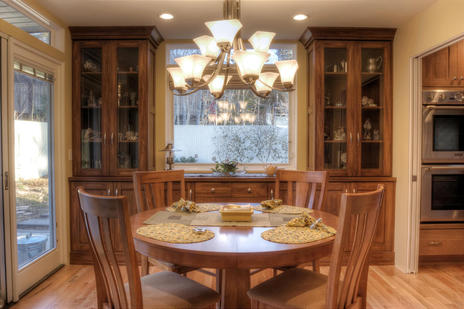A home is a very complex concept, both psychologically and physically. Psychologically, “home” represents such ideas as shelter, gathering and safety. Physically, the whole is the sum of many diverse elements constituting both the interior and exterior of the structure.
When you want to remodel your home, you don’t have to become an expert in every aspect of home design and construction. This is why there are professionals that specialize in all the different aspects involved in a remodeling project.
Besides selecting paint and furniture, interior designer Julie Yates with Atmosphere ID designed the built-in cabinets around a new window that was added by the architect.
As we have said before, compiling a great team of educated and experienced professionals is the first step to completing a successful project.
You are obviously the captain of the team. Unless you are the ultimate do-it-yourselfer, you will see the need to add an experienced contractor to the team to oversee the actual construction. If you have been reading this column for any length of time, you will also see the need to include design professionals to determine exactly what the contractor will build.
For any project requiring structural changes — inside or out — you should add an architect to your team. He or she will help you see many different possibilities, prioritize your needs, create a master plan, and help you determine and respect a reasonable budget. Even if you don’t anticipate major structural changes, an architect can help you see your home in a new light.
Another design professional to consider hiring is an interior designer. For more simple projects, an interior designer may be all you need in the design area; for more complex problems, they can work in conjunction with the architect toward the end of each person focusing on their particular areas of expertise.
You certainly don’t want to be paying two people to do the same thing! There are some areas of overlapping design concern for an architect and interior designer which involve items permanently affixed to the structure, such as windows, tile, flooring, etc., and which will require close cooperation and teamwork.
Other items (such as furniture, carpet, window coverings) will fall more clearly into the interior designer’s responsibilities.
There is a distinction between an interior designer and a “decorator” or design consultant.
The term interior designer implies more formal education (either a two-year or four-year degree). While there is a national licensing exam for interior designers (see The National Council for Interior Designer Qualification), licensing is not required in Utah. There are also two national associations — the American Society of Interior Designers and the International Interior Design Association — which provide continuing education and other collaborative benefits, but which have no exam or licensing status.
Interior design fees are often calculated on an hourly basis. This fee ranges from about $60-$100 per hour for a design consultant and from $80 per hour and up for an interior designer. When ordering furniture, fabric or accessories, a markup is often placed on the wholesale prices paid by the designer which pays for their time while still providing the product to the home owner at a cost less than retail.
Design consultants either work with independent firms or a supplier. Most furniture stores and showrooms have design consultants on staff. Showroom design consultants tend to be less expensive than independent consultants but are more limited than an independent consultant.
Because these consultants represent a specific supplier, they are encouraged to source in-house. With that said, you run the risk of your home looking like the showroom floor opposed to a unique, individualized design.
If you hire an independent design consultant, they are able to go out and search for the best deal and source from various suppliers. An independent design consultant may be able to find you a better deal that works with a more unique style.
While all design professionals can help you create a master plan and choose a color scheme, independent design consultants are more apt to helping you re-purpose your own items, work with vintage or thrift pieces, and mix high- and low-priced items, which will help you save money overall.
When selecting an interior designer or design consultant, ask for referrals, interview several candidates, ask to see portfolios and speak to references.
Discuss their educational background and their experience in the field. Find a consultant you are comfortable with and that you trust.
When you hire a design consultant you should expect a good listener, someone who is interested in your concerns and vision, as well as someone who is organized, creative, mindful of the budget and a good team player. They may see a design scheme for your home that you never would have thought of yourself. Basically, a design consultant on your professional team will be one more person to help you through the choices that will leave you loving your space.
Architects Ann Robinson and Annie V. Schwemmer are the founders of Renovation Design Group, www.renovationdesigngroup.com, a local design firm specializing in home remodels.

